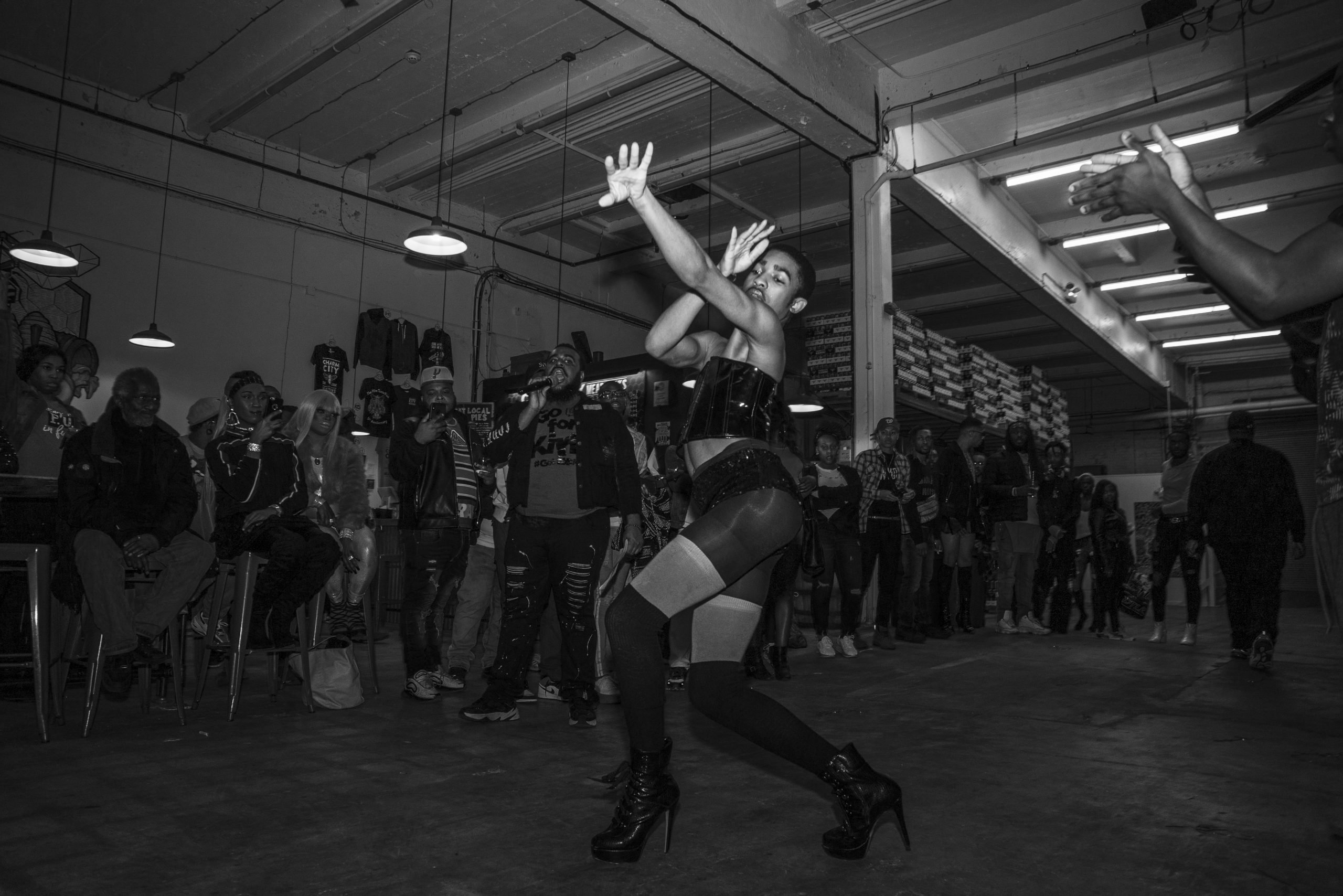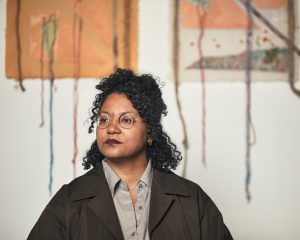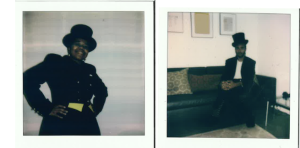Featured image: 007, Shan Wallace, 30 x 24 x 1.75 inches (framed in black) (76.2 x 61 x 4.45 cm) 30 x 24 inches (unframed) (76.2 x 61 cm), 2020. A black and white showing a group of people dancing. Courtesy of the artist and FLXST Contemporary.
The words “won’t you celebrate with me“—the title of Erin LeAnn Mitchell and Shan Wallace’s duo exhibition at FLXST Contemporary in Chicago—comes from the title of a poem from acclaimed Black poet Lucille Clifton. In the poem, Clifton declares for a celebration of her shapeshifting, of her molding, and of her becoming simply true to all of the multitudes that live within and through her. Clifton points to the challenges and obstacles that she’s faced and understands that the world may want to take her tenderness and joy away, but she crafts her own worlds where she is undoubtedly celebrated, uplifted, and loved for her triumphs everyday. In their two-person exhibition, artists Mitchell and Wallace continue this declaration of jubilee, pointing to a Black femme supremacy that complicates traditional understandings of Black femme subjectivity and gestures towards elation, boldness, and, more subtly, freedom. The audacity to celebrate in the face of constant threat is bold, yet both artists pay tribute to our collective everlasting choice of joy and not despair.
The exhibition comprises ten different works encompassing paintings, collages, and photographs, dense in their appearance and emotional presence. Though their presentation and techinques may be familiar to the viewer, some of the materials used in the exhibition—Mitchell’s use of fabric appliqué, beads, spray paint, cowrie shells, and sequins, and Wallace’s use of repurposing photographs that are then woven into poetically collaged images—appear magically futuristic; a kaleidoscope of dreams. Both artist are likened to paying homage and furthering a continuation of the work of powerhouses such as Faith Ringgold and Carrie Mae Weems in the ways they combine both the past and a shared Black archived experience of what it means to be a Black femme artist, creating images that allow us to see into the future. Wallace’s intimate photographs and collages build a different type of temporality and lens in conversation with Mitchell’s striking paintings and textile work.
The way these dreams of a Black femme future are crafted as stories of resilience and liberation are somehow told in the same breathe—the way the past has touched us, and contextualized every space we occupy is overwhelmingly revealed. What Mitchell and Wallace have done so tenderly is narrate an intimate story of Black femme (self) discovery–and this story is made true in won’t you celebrate with me.
This interview was edited for length and clarity.

Isra Rene: The work is so rich; the layering and repurposing of materials that you both use tap into a radical Black re-imagination focused on Black femme subjectivity. There’s a soft resistance in the ways that you’ve incorporated and made new meaning with sacred materials sourced directly from our shared Black experience. Can you talk about what inspires your work?
Erin LeAnn Mitchell: First of all, the beauty supply store is maybe my favorite place ever. Most of them are these imaginative worlds where I am transported into another realm. There’s something about it that is really magical. I source these elements–beads, cowrie shells, jewels, etc.–because they make me feel good. They draw a line directly back to Black women. Black women are always on my mind and I make a point to keep them in the forefront of my imagery. I feel most comfortable using these objects because they’ve always been around me. It takes me back to a place where I find comfort and peace. So, when I’m working and having all these things on my mind, it’s really comforting.
SW: My collages are inspired by my imagination. It’s a reflection of what I’m imagining and have experienced and observed. I use my own photographs. So, even though I’m touching on history, and touching on my imagination in different realms of the universe, in my experience, the figures and the details are contemporary. In my collage work, I’m able to be a lot more creative. I’m able to tap into my creative impulses, I’m able to tap into where I am imaginatively. I like to build these figures in very specific ways. I like to show androgyny in my figures, to put an emphasis on place and space. And because I take so much time building them, the collages have a lot of different messages–messages that are very visible, and then some underlying invisible messages, details, or points that I’m trying to make or places that I’m trying to really take the viewer.
IR: Erin, the objects you are using gives the work a playful, accessible entry point. I imagine bringing my little sibling here and they are reminded of themselves in the work because they love cowrie shells and beads in their hair, and to see these objects used to tell another story aside from adornment is transformational.
ELM: You’re exactly right. It’s something that’s recognizable. Starting there gives you that entryway in this image. [points to Spinning Satellites] It acts as a passage or portal in a way. You’re able to enter into an accessible situation and realize that there’s so much more beyond that initial interaction. The more time you spend with the pieces, the more you’re able to delve into what’s going on.
IR: I love the positioning of these three images together. It’s like a kaleidoscope of dreams within a black hole. You’re presented with these figures that seem as though they’re in motion with every positioning that you make towards the work. Can you talk about the figures within your work and the fluidity inherent in each image?
ELM: I think of how we move through space. As far as space, I’m thinking of spaces that we are present within and spaces in ourselves that we are attempting to explore. I end up in this kind of space (black space), but I also arrive in the space of the ocean because both of these are realms that we don’t have full knowledge of because they’re so vast. No one knows the full knowledge of what’s in the ocean or in outer space. And in that way, it’s reminiscent of us as beings who don’t really know ourselves and our capabilities because we don’t have that full back history, but we’re also trying to reclaim these histories for ourselves. All the while [we are] exploring and learning things about us that we need to add to our repertoire and build more understanding around how we’re here, why we’re here, what we’re doing, and the power that we hold. Movement has become something really big to me. I want there to be some type of movement in yourself when engaging with the work. I want the energy of the work to take you somewhere because we’re not still, we’re always moving.
IR: Every atom is in motion.
ELM: And women particularly, we always have moves to make and things to do. It’s just a constant thing that’s always happening and always evolving.
IR: The themes in your works are situated between an Afrofuturist landing and a calling in. Erin, your layering of paints, fibers, materials, and textiles reminds me of my grandmother, and Shan, you’ve used your personal archive and collaborations to imagine different stories and entry points with your collages. How do you pull in these different modes of production and make them unique to your experience or the stories you want to tell?
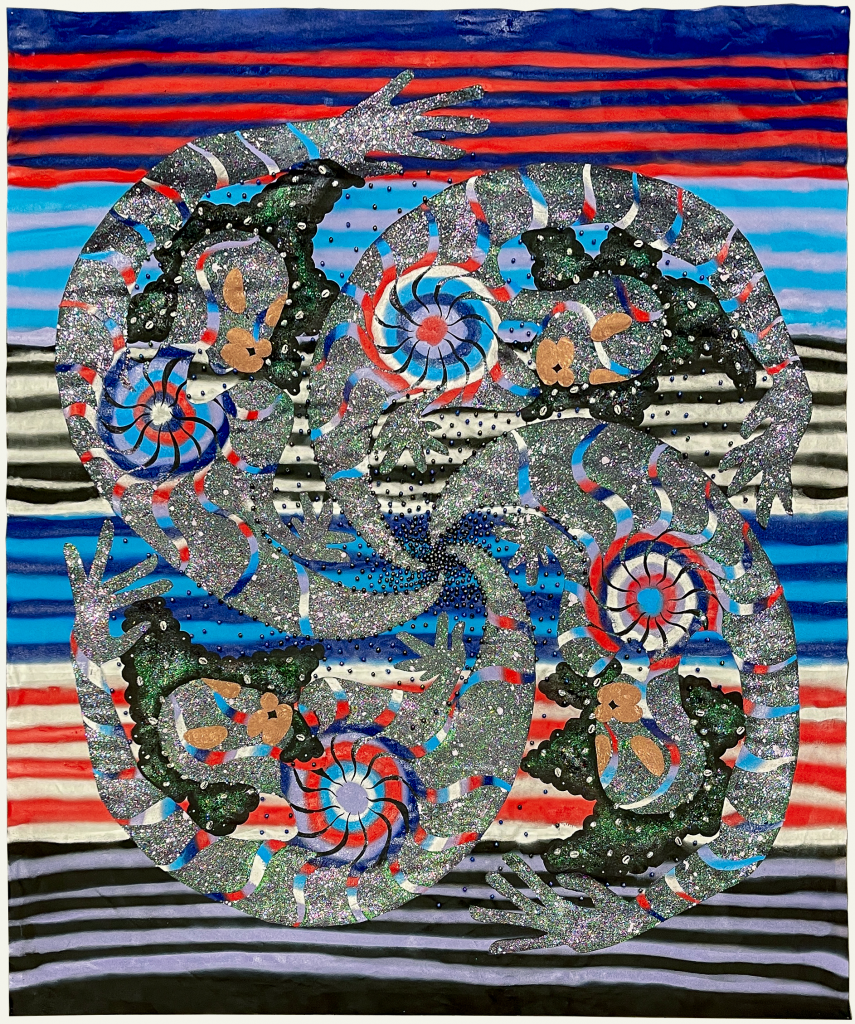
ELM: That’s interesting. I’m going with what feels natural and what feels good to me. There’s definitely some nostalgia there with putting the types of materials together and working with fabrics that recall my great grandmother, who always made things. I remember she literally made me this beautiful backpack that I always think about and it reminds me of my process of constantly adding to or layering with my work. [It] makes me think of how talented she was artistically. She’s always in my mind when I’m making and I bring those rememberings into a future where southern quilting is experimented with. I don’t want to call my pieces quilts because it isn’t really a quilt, but it’s definitely inspired by quilting.
SW: While I like to be in control of my creative process as much as I can, I think that it’s only right that I use my own photographs. It’s a way for me to continue the collaborative relationship between my sitters and subjects. It’s a way to really keep community, keep Black people, and keep my observations and my photographs a part of the creative process. As a photographer, the process is much different than the collage, it’s a lot more creative, I have a lot more time. I can make mistakes, and just layer and layer and think and remake and layer. The process is a lot more nurturing. There’s more space to just be with the photography, especially. I don’t have a lot of second chances, particularly with my street photography and with my portrait work. It’s really nice to intersect the two–to use my own photographs to make the collages and to include all of the people and strangers who become family, as well as the family who I’ve grown closer to because of it. It’s nice to insert that into the collage work.
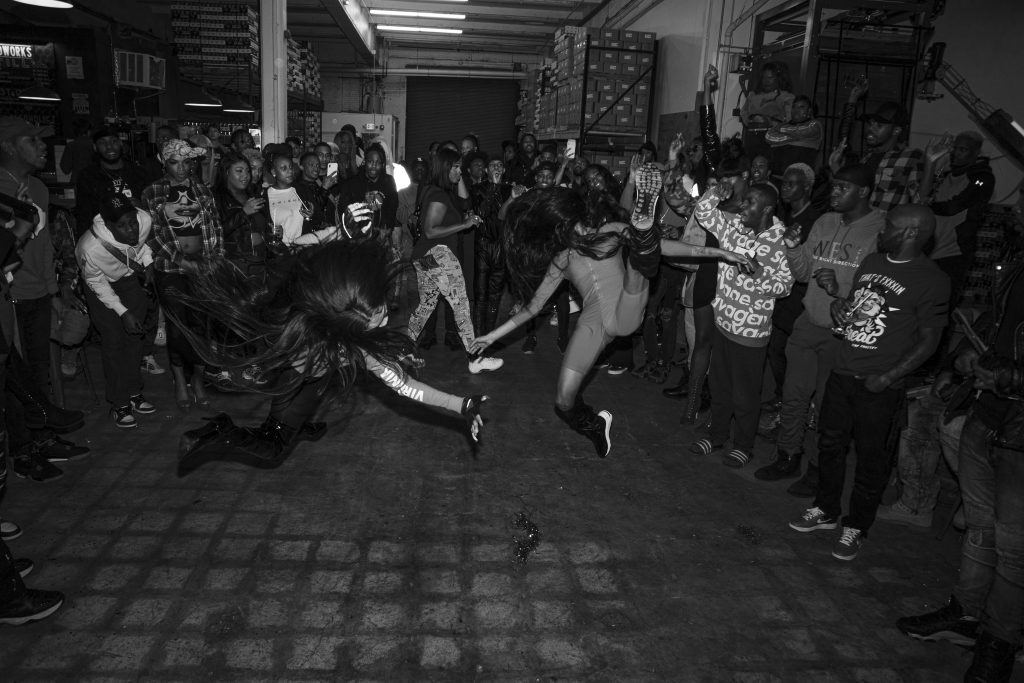
IR: I think we can use this unique time we’re in to redefine things as time shifts and changes. Our ancestors have qualified us to do that. Our existence here in this realm qualifies us to do that. We’re in a space, globally and communally, to revisit the ways that our ancestors have used different creative mediums and techniques to communicate with one another when they couldn’t see one another or touch or speak to each other in intimate ways. This current pandemic and the isolation that we’ve experienced on a massive scale, I think, has ushered us to rethink the ways that we can communicate with one another intimately outside of social media.
ELM: You’re definitely right. We have the opportunity now to redefine traditional ways of making and asserting a standard of accessibility.
IR: The works in the show are so vast and vibrant. They draw me in what seems like an everlasting embrace. I’m wondering when you both feel as though you’ve come to a finished point with a piece? Can you talk a bit about the importance of creating your own narratives at every step of your creative process?
ELM: Honestly, I’ve lived with this piece [points to Spinning Satellites] for a few months because it went through phases. I thought it was finished, but it was nowhere near finished [laughs]. I like that. Normally, I’ll have time where I can live with it where I’m not touching it and I’m usually working on other things at this time. I simply need space from it where I can really cleanse my mind and eyes so that I can focus on what’s working and what’s not. Honestly, it can be difficult to describe because it’s just a feeling for me. When you look at it, you get a sense of wholeness – a sense of hope. I just feel completed. Most people tell me my work is a lot to grasp in a good way. And it is a lot to take in, but I do that because I want you to spend time with it. Our attention spans are so short, so if I am able to hold you for two or more seconds with the work, I believe that in that time you can gain something or take something from it, or it may just leave you puzzled. I’m ok with that.
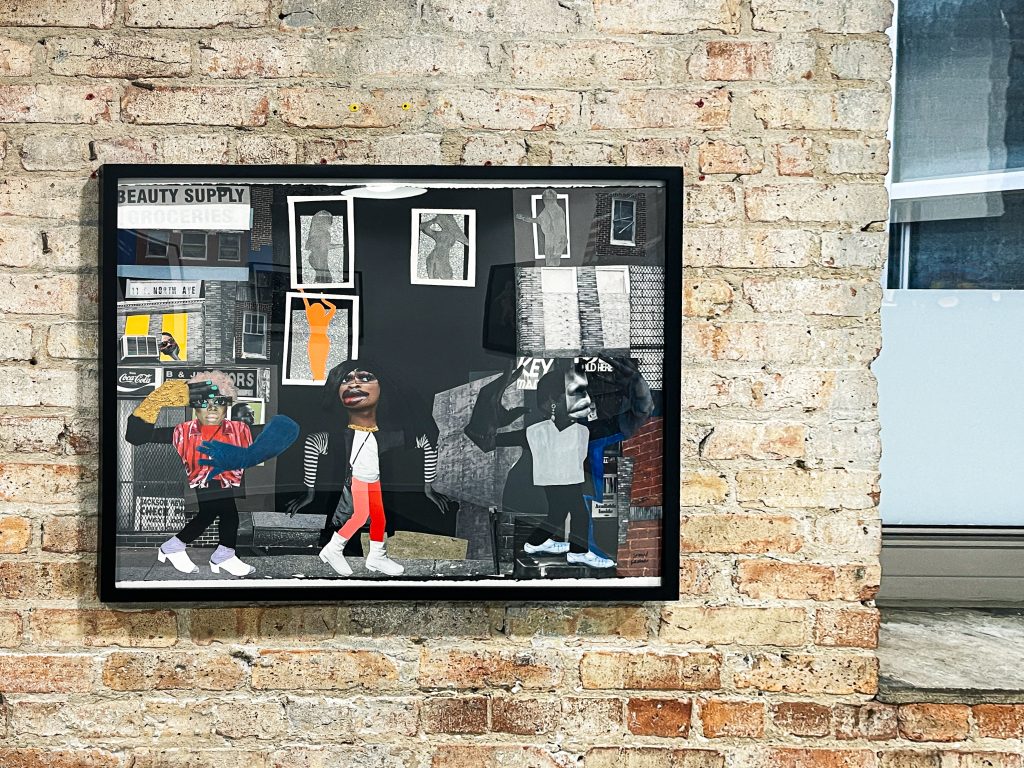
SW: I really enjoy using my own photographs. It allows me to see my photographs differently [and] give them a different type of functionality. The collage work has certainly shifted the way that I take photographs, what I’m seeing, what I’m noticing, and the amount of brain power that I use when I am taking photographs. I’m grateful for the growth in both parts: mediums and practices. I like to be very tedious about things and I like for that to be on my own time. And so with the collages, I have that.
IR: Erin, I have to ask about your relationship to Angela Davis! I believe what Angela means to you, Grace Lee Boggs means to me. Interestingly enough, they were often in conversation with one another, intentionally and not, about world crafting – crafting your worlds and lived experiences from dreams that center on radical love, no police, and interdependence.
ELM: It was a really surreal experience to meet her and have a piece of my work to celebrate and honor her. [A piece of mine] was gifted to her from the city of Birmingham to show our appreciation, which was really interesting at the time because she was being shunned from receiving the humanitarian award in the same city. Overall, it felt like a really monumental moment. I suddenly felt as though I stepped into history and was really excited about it. The most exciting part for me is that we’re both Birmingham natives and I’m sharing this moment with a globally known activist. I was simply in awe of everything that she’s done and knowing that we’re both coming from the same place granted me the possibility to know that I can do these things too. The possibilities are truly endless.
IR: What are ways that you are shifting and shaping possibilities in your own world?
ELM: Mainly, I’m living on my own terms and keeping faith in my abilities and knowledge that I’ve gained. I have the energy, I have the knowledge, I have the know how, and the means to move how I want to. I never want to box myself in a safe position. I want to be like Dr. Davis, to move in ways that are beneficial to me, but also, ways that could help someone else who simply witnessed me in my agency. I encourage my friends to follow their passions through my actions of following my own passions. That support doesn’t always have to happen on a global scale, it can happen within your circle. Waking up and choosing to live how I want to live and centering what I love to do the most gives a lot of people a boost to show up for themselves in the same way. I ask myself, “Where can I go to meet new people and make new connections?” or, “How can I advance my skills by studying from different resources?” Platforms like Instagram help to illuminate, in a particular way, the day to day of an artist’s life because a lot of people don’t know what that encompasses. I try to share my insights and my passion for my work and that, if I can do it, anyone can.
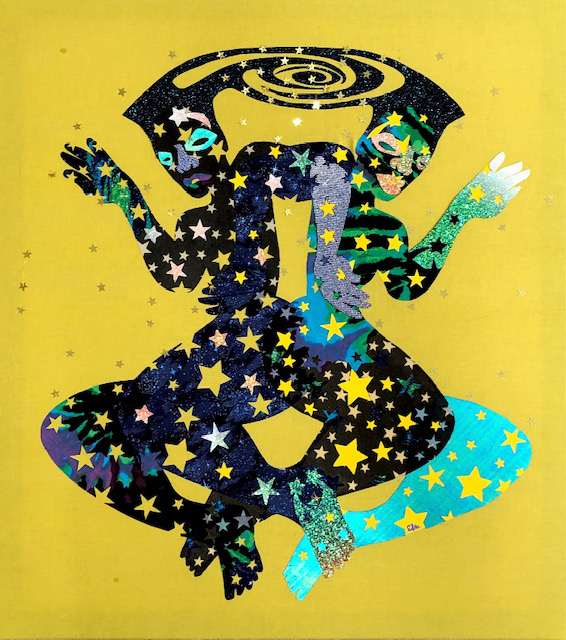
IR: Why Chicago?
ELM: A lot of people assume I’m from Chicago. I’ve done a lot of things here and have a tremendous amount of my practice connected to this city in the ways that it has evolved. But honestly, outside of wanting to dedicate myself more to art, going home to Birmingham meant me reclaiming myself as a southern artist. At the time, I really couldn’t name any Black women artists from Birmingham, Alabama, and a lot of people don’t know that [Kerry James Marshall is] from Birmingham as well. Reclaiming myself as a southern artist is intentional and I didnt want that to be erased from my narrative. I want you to know that part of me. I’m proud of my southern roots. Being a Black southern woman definitely puts you within a different lens, especially with my furtisitic dreams and interpretations. Coming to Chicago was me coming into my future. While I was here, I gained as much as I could and once I felt as though Chicago served me, I was ready to go home. Being in Chicago, I learned a lot that I would not have been able to experience in Birmingham. I am very grateful that I was encouraged to explore the world outside of Alabama and experience other places. I think of my experience alongside the Great Migration of my ancestors. Jacob Lawerence is one of my favorite artists and I thought about that when I moved here to Chicago. I was reminded that migration is a real thing that is still being enacted today – moving to find better opportunities. Now I want to take all that I’ve learned back [home] with me. I want to have a presence there. I want to keep my connection to the South. It’s my calling.
IR: The South has something to say!
ELM: Indeed.
won’t you celebrate with me was on view at FLXST Contemporary from May 1 to June 27, 2021.
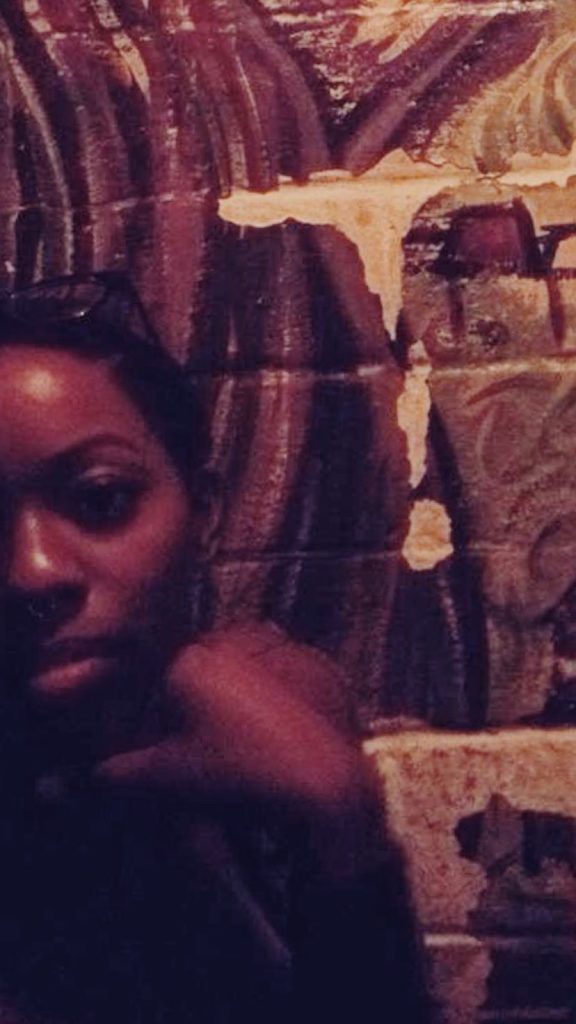
isra rene is a curator of care weaving webs of dreams tufted by our inherent connections of love, vulnerability, and care.
